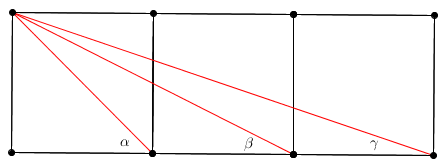The Three Square Problem

This original problem asks for the sum of the angles alpha, beta, and gamma, which has been proven to be 90 degrees. If the squares were lined up infinitely many times, creating infinitely many angles by drawing lines from the top left corner of the first square to the bottom right corner of each consecutive square, what would be the sum of all the angles?
No vote yet
1 vote
Easy Math Editor
This discussion board is a place to discuss our Daily Challenges and the math and science related to those challenges. Explanations are more than just a solution — they should explain the steps and thinking strategies that you used to obtain the solution. Comments should further the discussion of math and science.
When posting on Brilliant:
*italics*or_italics_**bold**or__bold__paragraph 1
paragraph 2
[example link](https://brilliant.org)> This is a quote# I indented these lines # 4 spaces, and now they show # up as a code block. print "hello world"\(...\)or\[...\]to ensure proper formatting.2 \times 32^{34}a_{i-1}\frac{2}{3}\sqrt{2}\sum_{i=1}^3\sin \theta\boxed{123}Comments
This can be written as
∑n=1∞arctann1
Which does not converge..
Log in to reply
But why not? The items in the sequence converge to 0 at infinity, so why doesn't the series converge?